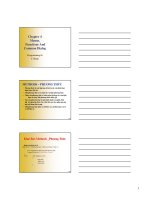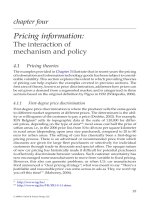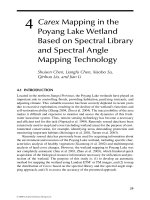Chapter 4 Menus, Functions And Common Dialog
Bạn đang xem bản rút gọn của tài liệu. Xem và tải ngay bản đầy đủ của tài liệu tại đây (141.51 KB, 12 trang )
1
Chapter 4
Menus,
Functions And
Common Dialog
Programming In
C Sharp
©2009
4-2
METHODS – PHƯƠNG THỨC
• Phương thức làmột tập hợp trình tự các câu lệnh thực
hiện được đặt tên.
• Mỗi phương thức sẽ cómột tên và thân phương thức
• Thân của phương thức sẽ chứa một tập hợp các câu lệnh
thực sự chạy khi phương thức được gọi.
• Tên của phương thực làmột định danh cónghĩa. Khi
đặt tên phương thức chú ý đặt tên sao cho ngắn gọn gợi
nhớ nội dung bên trong.
• Mỗi phương thức điều códữliệu vào, dữ liệu được xử lí
vàdữliệu ra.
©2009
4-3
Khai Báo Methods _Phương Thức
• Dạng 1 cógiátrị trả về
<Kiểu trả về> <Tên phương thức> (Danh sách tham số nếu có)
{
// Các câu lệnh thực hiện trong thân phương thức
< return Giátrị trả về > // bắt buộc córeturn
}
Vídụ: long Tong(int a, int b)
{
long lngS;
lngS= a+b;
return lngS ;
}
2
©2009
4-4
Khai Báo Methods _Phương Thức
Dạng 2 không cógiátrị trả về
<void> <Tên phương thức> (Danh sách tham số nếu có)
{
// Các câu lệnh thực hiện trong thân phương thức
// chúý không cócâu lệnh return
}
Vídụ: static void sapXep(int a, int b)
{
int tam;
tam=a;
a=b;
b=tam;
}
©2009
4-5
Lời Gọi Phương Thức
• <Class Name>.<Phương thức>(tham số) nếu trong cùng class thì
cóthể bỏ class Name
Vídụ:
private void btnNhan_Click(object sender, EventArgs e)
{
int intA;
double dblB;
intA = Convert.ToInt32(txtSoA.Text);
dblB= Convert.ToDouble(txtSoB.Text);
lblKQ.Text = HamTich(intA, dblB).ToString();
}
double HamTich(int A, Double dblB)
{
// lenh cua ham
return (A * dblB);
}
©2009
4-6
Passing Arguments To Methods
• Value Types: Kiểu trị
+ Bao gồm dữ liệu của các kiểu cơ bản và
dữ liệu của người lập trình tạo ra.
• Reference Type: Kiểu tham chiếu
+Chứa dựng một địa chỉ để chỉ đến bộ nhớ nơi
màdữliệu được cất trữ. Hoặc do người lập
trình tạo ra kiểu tham chiếu.
3
©2009
4-7
Truyền đối số làtham trị trong Methods
Truyền tham trị: Khi truyền đối số cho một Method nếu đối số của
chúng ta làmột tham trị thìgiátrị của đối số turyền vào sẽ được
giữ nguyên sau khi ra khỏi Method mặc cho trong thân Method co
sự thay đổi giátrị tham số
Vídụ:
double HamTich(int A, Double dblB)
{
// lenh cua ham
return (A * dblB);
}
Tham trị
©2009
4-8
Truyền đối số làtham chiếu trong Methods
Truyền tham chiếu: Khi truyền đối số cho một Method nếu đối số
của chúng ta làmột tham chiếu thìgiátrị của đối số turyền vào
sẽ được giữ thay đổi khi ra khỏi Method nếu trong thân Method
cósự thay đổi giátrị tham số.
void Tinh(int intA, ref int intB, out double dblC)
{
// out phải gán giátrị trước khi thao tác
intA += 10;
intB += 10;
dblC = 0;
dblC += 10;
dblC = Math.Sqrt(dblC);
}
Tham biến
©2009
4-9
VídụViết Qua Methods
private void btnTru_Click(object sender, EventArgs e)
{
//int intHieu;
//intHieu = MamHieu();
//lblKQ.Text = intHieu.ToString();
lblKQ.Text = MamHieu().ToString();
}
int MamHieu()
{
int intA, intB;
intA = Convert.ToInt32(txtSoA.Text);
intB = Convert.ToInt32(txtSoB.Text);
return intA -intB;
}
4
©2009
4-10
VídụViết Qua Methods
private void btnTinh_Click(object sender, EventArgs e)
{
int intA, intB; double dblC=0;
intA = Convert.ToInt16( txtSoA.Text);
intB = Convert.ToInt32( txtSoB.Text);
lblATruoc.Text = intA.ToString();
lblBTruoc.Text = intB.ToString();
lblSoCTruoc.Text = dblC.ToString();
Tinh(intA, ref intB, out dblC);
lblASau.Text = intA.ToString();
lblBSau.Text = intB.ToString();
lblSoCSau.Text = dblC.ToString();
}
void Tinh(int intA, ref int intB, out double dblC)
{
// out phải gán giátrị trước khi thao tác
intA += 10; intB += 10; dblC = 0; dblC += 10;
dblC = Math.Sqrt(dblC);
}
©2009
4-11
Menu Designer Initially
MainMenu Control
appears in
Component Tray
Type first Menu here
©2009
4-12
Using the Menu Designer
• To create the menus simply type where the
words "Type Here" appear at the top of the
form
• Include & symbol as you type to indicate
Keyboard Access Keys
• You are actually entering the Text property
for aMenuItemobject
• ChangeMenuItemobject names in the
Properties Window to include mnu prefix
5
©2009
4-13
Submenus
• Popup to the right of the menu
• Filled triangle to the right of the menu item
indicates to the user the existence of a
submenu
• Avoid more than one level deep
• Create submenus by moving to the right of
a menu item and typing the next item's text
©2009
4-14
SubMenus (cont.)
©2009
4-15
Separator Bars
• Used for grouping menu items according to
their purpose
• Visually represented as a bar across the
menu
• Create using one of two methods
– Typing a single hyphen for the text
– Right-click on Menu Designer where you want
separator bar and choose Insert Separator
6
©2009
4-16
Menu Properties
• Text
• Name, prefix =mnu
– Examples:mnuFileExit,mnuHelpAbout,
mnuFormatColorRed
• Checked, True/False (see coding tip p 204)
• Enabled, True/False
• Visible, True/False
©2009
4-17
Menu Design Standards
• Follow the industry standards for Windows
for names, order/location, access keys,
shortcut keys
• Basic Main Menus
File Edit View Format Help
©2009
4-18
File Menu Edit Menu
• New (Ctrl N)
• Open (Ctrl O)
• Close
• Save As
• Save (Ctrl S)
• Print (Ctrl P)
• Exit
• Undo (Ctrl Z)
• Cut (Ctrl X)
• Copy (Ctrl C)
• Paste (Ctrl V)
• Find (Ctrl F)
• Replace (Ctrl H)
7
©2009
4-19
Format Menu Help Menu
• Font
• Paragraph
• Alignment
• Color
• About (F1)
• System Information
View Menu
• Toolbar
• Status Bar
©2009
4-20
Modifying Menu Items Using
Menu Designer
• Right-Click the Menu Bar on the Form to
– Insert New menu
– Delete menu
– Insert Separator
– Edit Name, displays menu item Name property
rather than Text property on Form
• Drag and Drop menu items to new locations
©2009
4-21
VídụQua Menu
Submenu
Menu Items
8
©2009
4-22
Code Sử Dụng Menu
private void btnNhan_Click(object sender, EventArgs e)
{
int intA;
double dblB;
intA = Convert.ToInt32(txtSoA.Text);
dblB= Convert.ToDouble(txtSoB.Text);
lblKQ.Text = HamTich(intA, dblB).ToString();
}
double HamTich(int A, Double dblB)
{
// lenh cua ham
return (A * dblB);
}
private void mnuPhepTinhNhan_Click(object sender, EventArgs e)
{
btnNhan_Click( sender, e);// chỉ cần gọi lại
//trong event btnNhan_Click đã cólệnh rồi
}
©2009
4-23
Windows Common
Dialog Boxes (dlgprefix)
• Predefined standard dialog boxes for:
– File Open and Saving
– Printing and Previewing
– Color selection
– Font selection
• Add the Common Dialog control to form
– Appears in the Component Tray, pane at
bottom of Form Designer wherenondisplay
controls are shown
©2009
4-24
Color & Font Dialogs
9
©2009
4-25
Common Dialog Controls
• OpenFileDialog
• SaveFileDialog
• FontDialog
• ColorDialog
• PrintDialog
• PrintPreviewDialog
©2009
4-26
Displaying Common Dialog
• UseShowDialogMethod to display
common dialog at run time
• ShowDialogonly displays the dialog, it
doesn’t do anything else
dlgColor.ShowDialog( )
dlgFont.ShowDialog( )
dlgPrint.ShowDialog( )
©2009
4-27
Using the Common Dialog
Information
• Code must be written to retrieve and use the
choices made by the user in the Common
dialog
• Example
– Color Dialog displayed
– User selects color and clicks OK
– Code must be written to apply the selected
(dlgColor.Color) color to an object(s)
10
©2009
4-28
Set Initial Values for Color or
Font Common Dialogs
• In Windows, when a Color or Font
Common Dialog is displayed it normally
displays the current values of the object
being updated
• Before executing theShowDialogmethod,
you should therefore assign the Object's
existing values
©2009
4-29
Set Initial Values (cont.)
• Examples
– Changing the background color of a form
• Assign the current color to be selected when the
Color Dialog displays (otherwise black is selected)
– Changing the font of a label
• Assign the current font name, size, and style to be
selected when the Font Dialog displays
©2009
4-30
Kéo Thả Hộp Thoại
11
©2009
4-31
Color Dialog Example
• Change background color of a Label
private void mnuTuyChinhKieuMau_Click(object sender,
EventArgs e)
{
// Initialize Color Dialog
dlgColor.Color = lblKQ.ForeColor;
// Display Color Dialog
dlgColor.ShowDialog();
//'Apply user choice to object
lblKQ.ForeColor = dlgColor.Color;
}
©2009
4-32
Font Dialog Example
• Change font of a Label
private void mnuTuyChinhKieuFont_Click(object sender,
EventArgs e)
{
// Initialize font Dialog
dlgFont.Font = lblKQ.Font ;
// Display font Dialog
dlgFont.ShowDialog();
//'Apply user choice to object
lblKQ.Font = dlgFont.Font;
}
©2009
4-33
Context Menus
• Popup in response to right mouse click on
form or on a control
• Are specific to the component to which user
is pointing when right-clicking
• Also called Popup menus or Shortcut menus
• Do not have top level menus like the menu
bar
12
©2009
4-34
Creating Context Menus
• AddContextMenucontrol
– Appears in the Component Tray, pane at
bottom of Form Designer wherenondisplay
controls are shown
– Words "Context Menu" appear at the top of the
form
• Click on the words "Context Menu" and the
words "Type Here" appear underneath
• Proceed as you did for Menu Bar
©2009
4-35
Connecting Context Menu to
Object
• Use Context Menu's property window to give
it a standard name using themnuprefix
• Modify theContextMenuproperty of the
associated object so that this Context Menu
displays when user right-clicks the object
• If there is only one Context Menu connect it to
the form and it will display for the form and all
of the controls on the form
©2009
4-36
Context Menu
Contex menu









